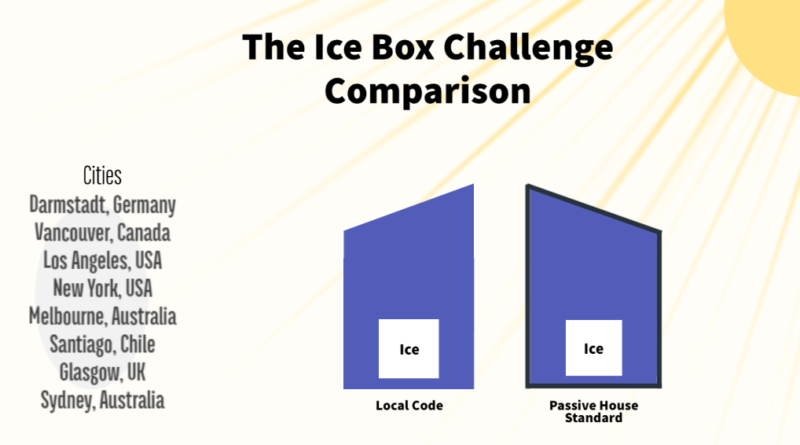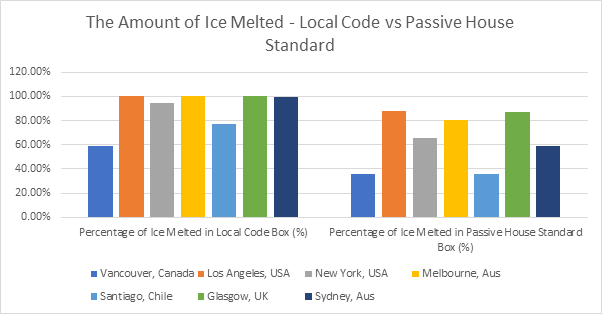The Ice Box Challenge has been around the world since 2016 and has been completed in different cities almost every year since.
First demonstrated in Germany, the premise of the Ice Box Challenge is to show how homes that are constructed to the Passive House Standard can help maintain internal temperature compared to individual country’s specific building standards, or codes.
Kicking off in Canada during 2017, one tonne of ice was put into two identical sized structure, one that was built to the BC Building Code and the other constructed in line with the Passive House Standard. After 18 days on the Vancouver waterfront, the boxes were opened. 639kg of ice remained in the Passive House box, compared to 407kg of ice in the BC Building Code box. What was interesting however that throughout the 18 days there was a high-pressure ridge across the region, so whilst the temperature in the box varied by less than a couple of degree the extra insulation in the walls floors and ceiling of the Passive House box, and the north facing window made a difference. This could be shown as there was a solid, straight edged block of ice, whereas the sun had ‘cut in’ to the Code box.
Next up was the Los Angeles Ice Box Challenge in 2018. 500lbs (≈227kg) of ice was deposited into the two structures, one Passive House standard and the other with Title 24 California Code Standard. The box with the local code was empty when officials opened the box after 7 days. In the Passive House box there was 61lbs (≈28kg) left, and with the temperature being only 70 degrees F (21 degrees Celsius). The code box however had the temperature of 92F (33C) this showing that the Passive House kept the heat out using a variety of Passive House requirements which are Climate specific insulation levels, Thermal Bridge Free Connections, High Performance Windows and Shades, Airtightness and Continuous Ventilation.
Also in 2018, was the Ice Box Challenge across the other side of the USA, in New York. 1800lbs (≈816kg) of ice were put into the two structures for one month in April/May 2018. The result was that the Passive House standard box had 756lbs (≈343kg) left, which was 42% of its original size. The box with Building Code Standard only had 126lbs left, which was 7% of its original size. Another win for the Passive House Standard.
Fast forward to February 2019, where ATTMA reported on the Melbourne Passive House IceBox Challenge. Again, two structures were filled with ice, this time with 720kg of ice. As with the usual Passive House Standard box there was the Australian Building Code. After 12 days there was 143kg left of ice in the Passive House whereas the ice has all melted in the Australian Code box. It was found that the Passive House was consistently 10 degree C cooler than the outdoors temperature.
After a 2-year break because of COVID, the Ice Box Challenge was back! This time in Santiago, Chile, part of the COP26 that took place in United Kingdom. The challenge also took place in Glasgow, Scotland. In Santiago, 1000kg were placed in the two structures, with the test being of the National Building Regs. After 10 days, there was 645kg in the Passive House structure and only 230kg of ice left in the National Building Regulations.
In the Glasgow box, which was presented with Passivhaus Trust in the UK, there was no ice left in the Scottish Code box and 121kg left in the Passive House Standard structure. This was 14 days after 917kg was put in both to start with.
And we come to present day with the most recent Ice Box Challenge taking place at the beginning of 2022 in Sydney. 1000kg was the starting amount of ice, with 413kg remaining in the Passive House Standard box and a nominal amount in the Australian Building Standard.
A direct comparison is hard to reach due to the differing number of days the ice was left in and the amount of ice that started the challenge. However, we can see from the below graph that the Passive House Standard performed comparatively well compared to each of the individual nations building standards in keeping the heat out of the temporary structures
From the data given, it does suggest that building to the Passive House standard could be part of the solution to ‘beat the heat’! ATTMA show members that have gone through the Passive House CPD which can be found here. And if you’d like attend the Low Energy Buildings CPD run by The Building Performance Hub you can find more details here






